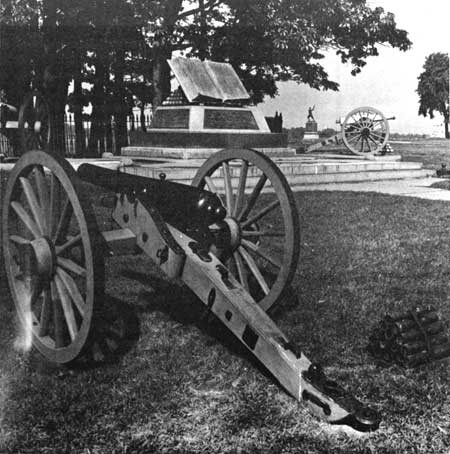|
GETTYSBURG National Military Park |
 |

The High Water Mark Monument, where Pickett's Charge was
stopped.
The Third Day (continued)
CAVALRY ACTION. As the strength of Lee's mighty effort at The Angle was ebbing and the scattered remnants of the charge were seeking shelter, action of a different kind was taking place on another field not far distant. Early in the afternoon, Stuart's cavalry was making its way down the valley of Cress Run, 3 miles east of Gettysburg. The brigades of Hampton and Fitzhugh Lee, at the rear of the line of march, momentarily lost the trail and came out into open ground at the north end of Rummel's Woods, Stuart, soon learning of the mistake, attempted to bring them into line and to proceed southward. But at this point, Gen. D. M. Gregg's Union cavalry, in position along the Hanover Road a mile southeast, saw the Confederates. Gregg prepared at once to attack, and Stuart had no choice but to fight on this ground. As the two forces moved closer, dismounted men opened a brisk fire, supported by the accurate shelling of artillerists.

Section of the Cyclorama painting of Pickett's
Charge by Paul Philippoteaux.
Courtesy Times and News
Publishing Company.
Then came the initial cavalry charge and countercharge. The Confederate Jenkins was forced to withdraw when his small supply of ammunition became exhausted. Hampton, Fitzhugh Lee, and Chambliss charged again and again, only to be met with the equally spirited counterattack of McIntosh. Custer's Michigan regiments assailed the front of the charging Confederate troopers, and Miller's squadron of the 3d Pennsylvania, disobeying orders to hold its position, struck opportunely on the Confederate left. The thrusts of the Union horsemen, so well coordinated, stopped the onslaught of Stuart's troopers. After 3 hours of turbulent action, the Confederates left the field and retired to the north of Gettysburg. The Union horsemen, holding their ground, had successfully cut off any prospect of Confederate cavalry aid in the rear of the Union lines on Cemetery Ridge.

|

|
|
Last Modified: Mon, Mar 4 2002 10:00:00 pm PDT |


